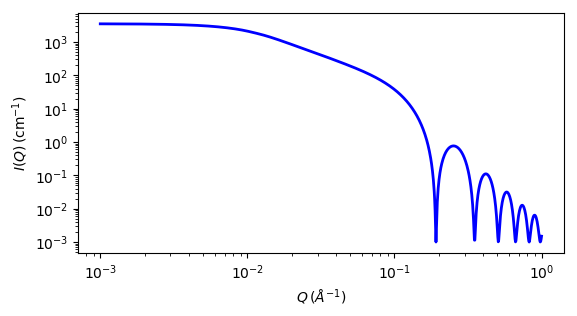flexible_cylinder
Flexible cylinder where the form factor is normalized by the volume of the cylinder.
| Parameter | Description | Units | Default value |
|---|---|---|---|
| scale | Scale factor or Volume fraction | None | 1 |
| background | Source background | cm-1 | 0.001 |
| length | Length of the flexible cylinder | Å | 1000 |
| kuhn_length | Kuhn length of the flexible cylinder | Å | 100 |
| radius | Radius of the flexible cylinder | Å | 20 |
| sld | Cylinder scattering length density | 10-6Å-2 | 1 |
| sld_solvent | Solvent scattering length density | 10-6Å-2 | 6.3 |
The returned value is scaled to units of cm-1 sr-1, absolute scale.
This model provides the form factor, \(P(q)\), for a flexible cylinder where the form factor is normalized by the volume of the cylinder. Inter-cylinder interactions are NOT provided for.
where the averaging \(\left<\ldots\right>\) is applied only for the 1D calculation
The 2D scattering intensity is the same as 1D, regardless of the orientation of the q vector which is defined as
Definitions

The chain of contour length, \(L\), (the total length) can be described as a chain of some number of locally stiff segments of length \(l_p\), the persistence length (the length along the cylinder over which the flexible cylinder can be considered a rigid rod). The Kuhn length \((b = 2*l_p)\) is also used to describe the stiffness of a chain.
In the parameters, the sld and sld_solvent represent the SLD of the cylinder and solvent respectively.
Our model uses the form factor calculations in reference [1] as implemented in a c-library provided by the NIST Center for Neutron Research (Kline, 2006). This states:
‘Method 3 With Excluded Volume’ is used. The model is a parametrization of simulations of a discrete representation of the worm-like chain model of Kratky and Porod applied in the pseudocontinuous limit. See equations (13,26-27) in the original reference for the details.
Note
There are several typos in the original reference that have been corrected by WRC [2]. Details of the corrections are in the reference below. Most notably
- Equation (13): the term \((1 - w(QR))\) should swap position with \(w(QR)\)
- Equations (23) and (24) are incorrect; WRC has entered these into Mathematica and solved analytically. The results were then converted to code.
- Equation (27) should be \(q0 = max(a3/(Rg^2)^{1/2},3)\) instead of \(max(a3*b(Rg^2)^{1/2},3)\)
- The scattering function is negative for a range of parameter values and q-values that are experimentally accessible. A correction function has been added to give the proper behavior.
This is a model with complex behaviour depending on the ratio of \(L/b\) and the reader is strongly encouraged to read reference [1] before use. In particular, the cylinder form factor used as the limiting case for long narrow rods will not be exactly correct for short and/or wide rods.

Fig. 29 1D plot corresponding to the default parameters of the model.
Source
flexible_cylinder.py
\(\ \star\ \) flexible_cylinder.c
\(\ \star\ \) lib/wrc_cyl.c
\(\ \star\ \) lib/sas_J1.c
\(\ \star\ \) lib/polevl.c
References
- J S Pedersen and P Schurtenberger. Scattering functions of semiflexible polymers with and without excluded volume effects. Macromolecules, 29 (1996) 7602-7612
Correction of the formula can be found in
- W R Chen, P D Butler and L J Magid, Incorporating Intermicellar Interactions in the Fitting of SANS Data from Cationic Wormlike Micelles. Langmuir, 22(15) 2006 6539-6548
Authorship and Verification
- Author:
- Last Modified by:
- Last Reviewed by: Steve King Date: March 6, 2020